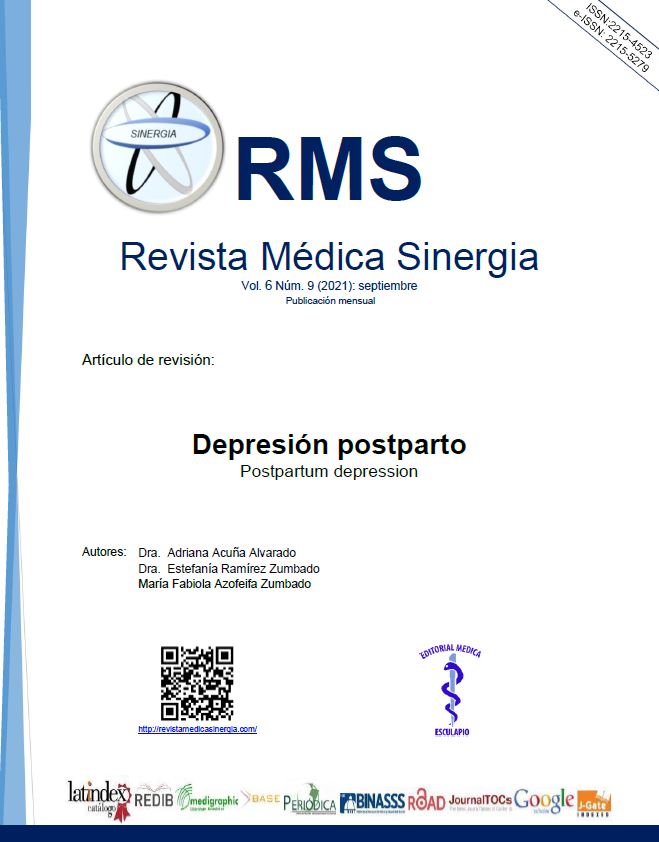Abstract
Postpartum depression is a disease that affects around 25% of the female population after pregnancy. It’s a disease associated with behavioral changes in the first 12 months postpartum and is one of the possible behavioral diagnosis related to postpartum. The social, psychological and physical adaptations that women undergo; in addition to the changes in a family, sentimental bondage with the baby, new responsibility as a mother and the physical changes in her body may cause depression. Therefore, early and immediate detection of this type of disease is necessary to try and avoid severity that can cause repercussions in the mother as well as the newborn. This article is a bibliographic review that gives an overview of postpartum depression and the specific details for a better evaluation of these patients in early stages.
Keywords
References
Escobar, J., Pacora, P., Custodio, N., y Villar, W. (2009, June). Depresión posparto: ¿se encuentra asociada a la violencia basada en género? In Anales de la Facultad de Medicina (Vol. 70, No. 2, pp. 115-118). UNMSM. Facultad de Medicina.
Jiménez Serrano, S. (2014). Desarrollo de modelos predictivos y una aplicación móvil para la predicción de la depresión posparto.
González, R. A., Tello, V. L., Salán, M. M., Fernández, P. F., del Rivero, V. D. C. A., y Díaz, M. N. F. (2017). Actualización en depresión posparto. TIEMPOS DE ENFERMERÍA Y SALUD, 1(3), 18-22.
Tortajada, S., Garcia-Gomez, J. M., Vicente, J., Sanjuán, J., de Frutos, R., Martín-Santos, R., ... y Robles, M. (2009). Prediction of postpartum depression using multilayer perceptrons and pruning. Methods of information in medicine, 48(03), 291-298.
Terrén, C. A., Esteve, L. G., Navarro, P., Aguado, J., Ojuel, J., y Tarragona, M. J. (2003). Prevalencia de la depresión posparto en las madres españolas: comparación de la estimación mediante la entrevista clínica estructurada y la escala de depresión posparto de Edimburgo. Medicina clínica, 120(9), 326-329.
Guintivano, J., Arad, M., Gould, T. D., Payne, J. L., y Kaminsky, Z. A. (2014). Antenatal prediction of postpartum depression with blood DNA methylation biomarkers. Molecular psychiatry, 19(5), 560-567.
Solano, M. S., Mejía, A. L. P., y Madrigal, J. C. (2019). Abordaje clínico y manejo de la depresión posparto. Revista Médica Sinergia, 4(6), 90-99.
Medina-Serdán, E. (2013). Diferencias entre la depresión posparto, la psicosis y la tristeza posparto. Perinatología y reproducción humana, 27(3), 185-193.
Heron J, McGuinness M, Robertson E, Craddock N y Jones, I. 2008. Early postpartum symptoms in puerperal psychosis. BJOG, 115, 348-53.
Decherney, A., Laufer, N., Nathan, L. y Roman, A. (2014). Diagnóstico y tratamiento ginecoobstétricos. XI Edición. Nueva York: Lange Medical Book/McGraw-Hill.
Loaiza, N. V., Dachner, A. P., y Morales, J. A. V. (2019). Generalidades y diagnóstico de la depresión posparto. Revista Médica Sinergia, 4(7), e261-e261.
Bourget, D., Grace, J., y Whitehurst, L. (2007). A review of maternal and paternal filicide. Journal-American Academy of Psychiatry and The Law, 35(1), 74.
Shariatpanaahi, M. V., Shariatpanaahi, Z. V., Moshtaaghi, M., Shahbaazi, S. H., y Abadi, A. (2007). The relationship between depression and serum ferritin level. European journal of clinical nutrition, 61(4), 532-535.
Mendoza, C., y Saldivia, S. (2015). Actualización en depresión posparto: el desafío permanente de optimizar su detección y abordaje. Revista médica de Chile, 143(7), 887-894.
Malpartida, A. M. K. (2020). Depresión posparto en atención primaria. Revista Médica Sinergia, 5(02), 355-355.
Meléndez, M., Díaz, M., Bohorjas, L., Cabaña, A., Casas, J., Castrillo, M., y Corbino, J. (2017). Depresión posparto y los factores de riesgo. Salud, 21(3), 7-12.
Lasheras, G., Sender, B. F., y Serra, B. (2014). Detección in situ de la depresión posparto (DPP) y alteración del vínculo materno-filial en el Hospital Universitario Quirón Dexeus. Resultados preliminares. Cuadernos de medicina psicosomática y psiquiatría de enlace, (109), 22-31.
Dois, C. A. 2012. Actualizaciones en depresión posparto. Rev Cub Obst y Ginecol, 38(4), 576-586.
Sines, E., Syed, U., Wall, S., y Worley, H. (2007). Postnatal care: A critical opportunity to save mothers and newborns. Policy Perspectives on Newborn Health, 1(7).
Yonkers, K. A., Vigod, S., y Ross, L. E. (2012). Diagnosis, pathophysiology, and management of mood disorders in pregnant and postpartum women. Focus, 10(1), 51-66.
Putnam K, Robertson-Blackmore E, Sharkey K, Payne J, Bergink V., ... y Munk-Olsen T. 2015. Heterogeneity of postpartum depression: a latent class analysis. Lancet Psychiatry, 2(1). 67. https://doi.org/10.1016/S2215-0366(14)00055-8
Meltzer-Brody, S., y Jones, I. (2015). Optimizing the treatment of mood disorders in the perinatal period. Dialogues in clinical neuroscience, 17(2), 207.
Nóblega, M. 2009. La maternidad en la vida de las adolescentes: implicancias para la acción. Lima, Rev Psicol, 27(1), 29-54.
Masías, S. M. A., y Arias, G. W. L. (2018). Prevalencia de la depresión post parto en Arequipa, Perú. Revista Medica Herediana, 29(4), 226-231.
Barbosa, M. A. R. D. S., y Ângelo, M. (2016). Experiencias y significados de la depresión posparto de mujeres en el contexto de la familia. Enfermería Global, 15(42), 232-255.

This work is licensed under a Creative Commons Attribution-NonCommercial 4.0 International License.
Copyright (c) 2021 Array


